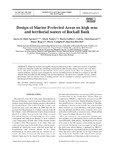Design of Marine Protected Areas on high seas and territorial waters of Rockall Bank
| dc.contributor.author | Hall-Spencer, Jason | |
| dc.contributor.author | Tasker, M | |
| dc.contributor.author | Soffker, M | |
| dc.contributor.author | Christiansen, S | |
| dc.contributor.author | Rogers, S | |
| dc.contributor.author | Campbell, M | |
| dc.contributor.author | Hoydal, K | |
| dc.date.accessioned | 2013-02-20T10:45:18Z | |
| dc.date.available | 2013-02-20T10:45:18Z | |
| dc.date.issued | 2009-12-17 | |
| dc.identifier.issn | 0171-8630 | |
| dc.identifier.issn | 1616-1599 | |
| dc.identifier.uri | http://hdl.handle.net/10026.1/1340 | |
| dc.description.abstract |
Fisheries closures are rapidly being developed to protect vulnerable marine ecosystems worldwide. Satellite monitoring of fishing vessel activity indicates that these closures can work effectively with good compliance by international fleets even in remote areas. Here we summarise how remote fisheries closures were designed to protect Lophelia pertusa habitat in a region of the NE Atlantic that straddles the EU fishing zone and the high seas. We show how scientific records, fishers' knowledge and surveillance data on fishing activity can be combined to provide a powerful tool for the design of Marine Protected Areas. © Inter-Research 2009. | |
| dc.format.extent | 305-308 | |
| dc.language | en | |
| dc.language.iso | en | |
| dc.publisher | Inter-Research Science Center | |
| dc.subject | Lophelia pertusa | |
| dc.subject | MPA | |
| dc.subject | Fisheries | |
| dc.subject | Offshore | |
| dc.subject | Marine Protected Area | |
| dc.subject | NE Atlantic | |
| dc.subject | Vessel monitoring system | |
| dc.subject | VMS | |
| dc.title | Design of Marine Protected Areas on high seas and territorial waters of Rockall Bank | |
| dc.type | journal-article | |
| dc.type | Journal Article | |
| plymouth.author-url | https://www.webofscience.com/api/gateway?GWVersion=2&SrcApp=PARTNER_APP&SrcAuth=LinksAMR&KeyUT=WOS:000273968400028&DestLinkType=FullRecord&DestApp=ALL_WOS&UsrCustomerID=11bb513d99f797142bcfeffcc58ea008 | |
| plymouth.volume | 397 | |
| plymouth.publication-status | Published | |
| plymouth.journal | Marine Ecology Progress Series | |
| dc.identifier.doi | 10.3354/meps08235 | |
| plymouth.organisational-group | /Plymouth | |
| plymouth.organisational-group | /Plymouth/Faculty of Science and Engineering | |
| plymouth.organisational-group | /Plymouth/Faculty of Science and Engineering/School of Biological and Marine Sciences | |
| plymouth.organisational-group | /Plymouth/PRIMaRE Publications | |
| plymouth.organisational-group | /Plymouth/REF 2021 Researchers by UoA | |
| plymouth.organisational-group | /Plymouth/REF 2021 Researchers by UoA/UoA07 Earth Systems and Environmental Sciences | |
| plymouth.organisational-group | /Plymouth/Research Groups | |
| plymouth.organisational-group | /Plymouth/Research Groups/Marine Institute | |
| plymouth.organisational-group | /Plymouth/Users by role | |
| plymouth.organisational-group | /Plymouth/Users by role/Academics | |
| dc.identifier.eissn | 1616-1599 | |
| dc.rights.embargoperiod | Not known | |
| rioxxterms.versionofrecord | 10.3354/meps08235 | |
| rioxxterms.licenseref.uri | http://www.rioxx.net/licenses/all-rights-reserved | |
| rioxxterms.type | Journal Article/Review |


